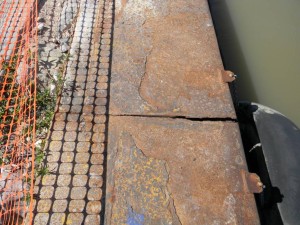 U.S. Forensic was hired to perform an evaluation of a bulkhead at a shorebase facility and to determine the cause and extent of the reported damage and provide a scope of repairs. The particular damage reported was that the top of the steel bulkhead was deflected outwards in the central area of the wall.
U.S. Forensic was hired to perform an evaluation of a bulkhead at a shorebase facility and to determine the cause and extent of the reported damage and provide a scope of repairs. The particular damage reported was that the top of the steel bulkhead was deflected outwards in the central area of the wall.
William R. Janowsky, Jr., P.E. performed the evaluation. Mr. Janowsky’s forensic engineering experience includes in-depth condition surveys and damage inspections of residential, commercial, and industrial buildings, docks and marine structures, bridges, and facility components. He has provided engineering consulting services for projects in the United States, United Kingdom, South America, and the Caribbean.
Case Background
The facility was utilized to transport materials, provisions, and personnel to and from supply vessels for delivery to various offshore structures and destinations. It was purchased two years earlier. At the time, site personnel noticed a crack in the surface soil near the location of the mobile crane along the central portion of the bulkhead and that the top of the bulkhead was displaced outwards slightly in that area. The manager reported that the mobile crane utilized at the property had been at the site since 2006 and though it had been moved around somewhat on occasion, the crane had typically been positioned near the central portion of the bulkhead. He also reported that there were no increases or changes in the type, size, or quantity of materials transferred during the period when they assumed the lease of the property.
Evaluation
Mr. Janowsky performed a thorough site inspection, reviewed the results of a dive inspection, and reviewed areal photographs of the site.
Retaining wall structures utilize stiff sheet pile sections to provide lateral confinement of soil along vertical slopes such as steep hillsides or docks along the edges of deep waterways. The sheet piles along the edge of a vertical cut may be designed to resist the lateral soil loads and deflection of the top of the wall with the bending strength of the sheets only, as in a cantilever wall arrangement, or as an anchored wall that utilizes a tie back system to resist the deflection of the sheets by attaching the upper portion of the retaining wall to a firm anchor component positioned landward of the cut. In either case, the wall must be designed to adequately resist the lateral loads associated with the restraint of the uneven soil levels on either side of the wall as well as additional lateral soil pressures caused by vertical surcharge loads applied to the ground surface along the higher side of the cut by stacked materials, buildings, equipment, or vehicles.
The central portion of the anchored steel sheet pile bulkhead was deflected outwards approximately 8 inches and subsequent excavation at the site revealed that at least 2 of the steel anchor rods in that area of the wall were disconnected or broken. There was no evidence of recent movement of the wall and close inspection of the 2 disconnected anchor rods revealed that the outer ends of each rod were deteriorated consistent with long-term corrosion of the steel material.
Conclusions
- The deflection of the top of the central portion of the steel sheet pile bulkhead at the shorebase facility was the result of a long-term, progressive failure of the steel tie rods and wale of the bulkhead anchor system that was caused by long-term deterioration of the steel components and lateral soil pressures imposed on the bulkhead by the long-term and on-going use of land-based cranes at the site.
- In order to repair the damage to the sheet pile bulkhead, Mr. Janowsky recommended that the anchor system be excavated and that the disconnected anchor rods be replaced with similar materials and properly connected to the existing steel sheet pile bulkhead and timber deadman anchors.
Photographs
- Deflection of the top of the wall of the bulkhead.
- Crack at a welded joint in the steel surface cap on the top of the bulkhead in the deflected area.
- View of site excavation performed to expose the tie rods and anchor system of the bulkhead. Note the steel tie rod visible in the foreground.
- View of a tie rod disconnected from the bulkhead in the deflected area of the wall.
- Close-up view of the end of a dislodged tie rod. Note the deterioration of the steel rod and the rounded corners of the nuts.
- Crack in the soil near the bulkhead. The photograph was taken two years prior.
For more information on related services, visit our Marine page.









